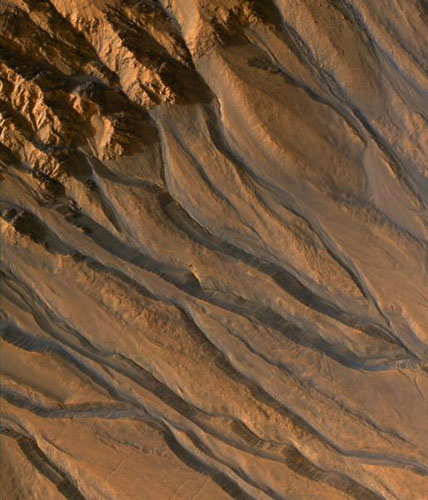Got Water?

Deputy Project Scientist - Mars Reconnaissance Orbiter
A theme of Mars exploration is “Follow the Water,” since understanding the history of water on our planetary neighbor will help us understand if there were environments favorable for life to occur and how climate has changed over time. This is because all life on Earth requires water and we assume the same applies elsewhere in the universe. The Mars Reconnaissance Orbiter has made numerous discoveries that have provided new insights into past wet environments on Mars, water vapor in the planet’s current atmosphere and ice in the subsurface. However, so far, liquid water remains elusive.
The Shallow Radar, or “SHARAD” instrument is the only one on the Mars orbiter that was designed with a goal of discovering liquid water below Mars’ surface. This ground-penetrating radar instrument, which was supplied by the Italian Space Agency, transmits a radar signal at approximately 20 megahertz, and receives any radar waves that bounce off the surface or subsurface layers. The radar instrument has sufficient strength to see layers to a depth of about one kilometer (a little more than one-half mile), and even deeper in the polar caps. Layers in the subsurface reflect the radar wave if there is sufficient contrast in their dielectric properties (their bulk electrical properties), as for example between dry sand and ice-filled sand. Water is a much better conductor than other geologic materials, and thus should be readily detected if present.

This image from NASA’s Mars Reconnaissance Orbiter shows gully channels in a crater in the southern highlands of Mars.The gullies emanating from the rocky cliffs near the crater’s rim (upper left) show meandering and braided patterns typical of water-carved channels. Image credit: NASA/JPL/University of Arizona
Of all the features believed to be formed by water on Mars, we have found only two gullies known to have recent flows – within the last 5-10 years. Gullies are narrow channels that emanate from cliff walls, starting well below the local ground surface. Dr. Michael Malin used the Mars Orbital Camera on Mars Global Surveyor to repeatedly image these features because of their fresh, unweathered appearance. These efforts led to the discovery of the two relatively new gullies.
To date, the Shallow Radar instrument’s observations of dozens of regions containing gullies show no evidence of liquid water. Since slopes of the cliffs where the two new gullies occur are extremely steep, some scientists put forth an alternate hypothesis in which dry debris tumbling downhill could have formed the latest channels. Yet many of the features observed at these and other gullies strongly suggest that liquid water had at least some role in carving the channels. These channels may have formed when a past climate change caused subsurface ice to melt. Or perhaps liquid water was trapped in a past aquifer. But for now, liquid water, if it exists today on Mars, remains out of reach of the Mars Reconnaissance Orbiter.
Tags: blog, discoveries, exploration, exploration water, jpl, Mars, mars exploration, mars reconnaissance, nasa, Planet, Solar System, space, university of arizona, water

